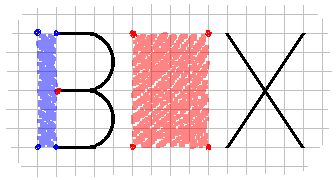
Box is an abstract 2-player game of territory control.
Box was created by Douglas Hoover circa 1990 and first released as an entry to the Thousand-Year Game Design Challenge.
The Board:
The game is played on a square grid, typically 10 x 10 squares in size (though any even-numbered size of at least 6 x 6 will work). The grid is initially empty; each intersection and each square can be marked with either of the two player colors.
Box is most commonly played with graph paper and pencils. Physical sets or computer programs can also be easily created.
Play:
The two players alternate turns. A player takes their turn by marking one empty intersection (including the edges and corners of the grid) with their color, and then claiming any "boxes" they have created.
A "box" is created whenever a player has all four corners of a rectangle marked with their color, and that rectangle does not contain within it any intersections or grid squares marked with the opponent's color. A box is claimed by permanently marking every grid square inside the box with the color of the player who created it.
Clarifications:
Intersections marked with the opposing color on the edge of a box do not block the creation of that box; thus, the creation of boxes that are only a single grid square wide cannot be blocked by an internal intersection of the opponent's color.
The edges of boxes must be horizontal and vertical (aligned to the grid). Squares (even just single grid squares) are also valid boxes, since squares are rectangles.
Boxes may overlap previously claimed boxes belonging to the same player.
Marking an intersection inside a previously claimed box is legal (though it is rarely useful to play inside an opponent's box).
During their turn a player may claim missed boxes created in previous turns, if they have not yet been blocked.
The First Move:
A first player is determined; that player places the first move, using either color. The other player then chooses which color they wish to play for the rest of the game. If they choose the color played as the first move, they claim the first move as their own and become the first player; the first player becomes second player, and plays the second move as well, using the other color. If they choose the other color, they remain the second player, and make their move as usual. After that, play proceeds normally.
Game End and Scoring:
A player who believes that no more scoring will occur in the game signifies this by passing their turn. When both players pass in succession, the game ends.At game end, each player scores one point for each grid square that is marked in their color. The player with the most points wins. There is no tiebreaker.
A player may also honorably resign, ending the game when they believe the winner is no longer in doubt (as a trivial example, when the other player has claimed more than 50 squares on a standard 10 x 10 board).
Etiquette:
For casual play, players may wish to agree to alert the other player whenever they have set up a scoring opportunity, similar to the custom of saying "atari" in a game of Go.
Nice players may also identify missed boxes that the other player has created. Boxes are only rarely missed, and it is not intended that this be a meaningful part of the game.
Supporting resources:
Here is an example of play. It does not contain any further clarifications, but may be useful to those who prefer to learn by example.This standard grid can also be printed out to play, if you don't have graph paper handy.
Options For Advanced Players:
Handicapping:
Handicapping can be easily accomplished either by giving the weaker player a number of points to start, or simply by giving them the first one or two moves outright.
Alternative First-Move Rules:
If players desire the first move can be taken normally, but it should be recognized that Box can give a significant edge to the first player -- just in initiative, if nothing else. If doing this, the player who lost the previous game should usually play first in the next game. Other ways to balance out the first player's advantage include giving the second player a number of points at the start (as in Go), or even bidding points at the start (in either whole or half-point increments) for the right to play first. It is recommended that even new players use some balancing technique; unlike many games, the first player's advantage in Box is not mitigated by having inexperienced players.
The rules of Box are Copyright 2011 by Douglas Hoover, under a Creative Commons Attribution License. Free distribution and use of these rules is encouraged, as long as proper attribution is retained.
maintained by Douglas Hoover | last updated 8/31/11
